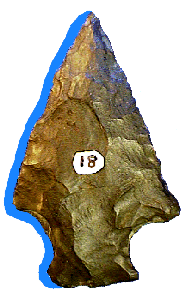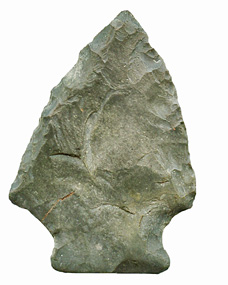



Point Type: SUSQUEHANNA
BROAD
Also See: Ashtabula , Forest Notched, Mansion
Inn, Perkiomen
, Waratan, Wayland Notched
Location: Northeastern United States
Associated Dates: 3700 - 2000 B.P. - Late Archaic
- Early Woodland
Morphology: Stemmed
General Description: The Susquehanna
Broad point is a medium to large size, broad, expanded stemmed point with
tapered to clipped wing shoulders. Blade
edges may be convex, straight or concave with asymmetry often present in larger
examples, but less asymmetry than with Perkiomen points. The blades are thin for
their size. Early examples often have ground
bases and stem edges. The base is usually straight or slightly
concave. The stems are short and contracting which terminate in expanded
flaring tangs
or corners.
It is assumed that due to the
asymmetrical nature of larger specimens, possibly caused by considerable resharpening, that they may have served
as knives, while smaller, more symmetrical specimens may have been used
as dart points.
The size range for the Susquehanna Broad point in
the 26 mm through 156 mm range with typical average length being between 38 mm
and 76 mm.
Some
Susquehannas appear to have had their pointed shoulders removed, and these have
been termed "Clipped Wing Susquehannas".
This point type
represents an intrusive culture that made
its way into New England and is thought to have originated in the Susquehanna
River valley of eastern Pennsylvania. In Pennsylvania, the preferred
lithic materials were jasper, dark rhyolite, Onondaga gray and black flints or
cherts, Flintridge flints and occasionally quartzite.
Some specimens have been found associated with
steatitie bowl sherds. The form and age of the Susquehanna indicate
a relationship with the Ashtabula point type.
The
Susquehanna Broad point was named by John Witthoft in 1953 for the Susquehanna
River Valley in eastern Pennsylvania.
About the Point Above (Left): The point pictured above on the left
hand side of the page is a medium sized somewhat symmetrical Susquehanna Broad point made
from a dark brownish black flint which may be Normanskill (Hudson Valley, New
York) in origin. The flint has a satiny patina and the point is very well made with
very sharp edges and fine edge retouch pressure flake
scars. If you look close, you will notice a long flute
from the base to the number marker. The base has been ground as
have the edges of the stem. The point measures 55 mm
in length, 33 mm at the widest point and is 7 mm thick
at its thickest point (the wings) with the typical thickness along the blade
being 6 mm. This point was found in my yard in Milford (Woodmont),
CT while digging a patio foundation. I wonder how this Normanskill flint came to
reside here in Milford? There must have been some trading or gifting
of materials with bands to the east? Catalog
Number 18-14-DV
About the Point Above
(Right): The point pictured above on the
right hand side of the page is a small sized somewhat symmetrical
Susquehanna Broad point made from a dull, dark gray material which may
be Normanskill (Hudson Valley, New York) in origin. The flint has a
very grainy and highly weathered patina. The point is nicely made with very
sharp edges and fine edge retouch pressure flake scars. The point
is very thin and flat. The base and notches have been ground. The
point measures 37 mm in length, 26 mm at the widest point which are
the shoulders and is only 6 mm thick at its thickest point (the wings)
with the typical thickness along the blade being 5 mm. This point was found
in East Hartford, Connecticut at the old Forbes Farm. Catalog Number 480-13-C
References: Boudreau, Fogelman, Justice (1), Kinsey, Overstreet, Perino (1), Ritchie, Waldorf
© Copyright 1997 - 2009 LITHICS-Net WWW.LITHICSNET.COM
Use your Browser's BACK Button to return to the LITHICS-Net Index.